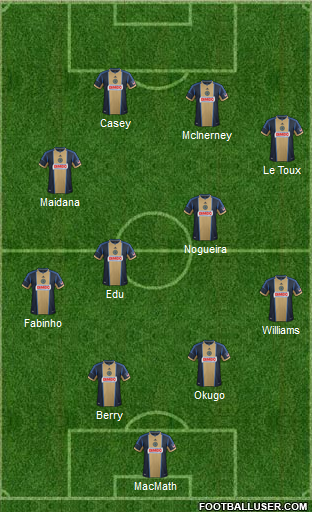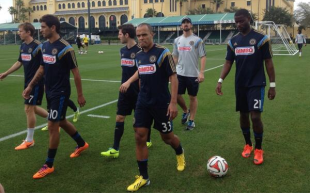Photo: Courtesy of Philadelphia Union
With all eyes set on Portland’s Providence Park for the unfortunately late kick-off of Philadelphia Union’s season (10:30 pm ET on CSN), PSP’s Eli Pearlman-Storch and Adam Cann have been going back and forth on the tactical options available to the Union their newly revamped, deeper-than-ever roster. Here is the second part of their conversation, beginning with Adam’s reply to a question about Jack McInerney’s efficiency in an unbalanced formation.
Adam Cann: A previous point you made — that McInerney became better at checking into midfield at the right times — should speak to this issue. The young striker got his plaudits for running the line well, but his overall reading of the game was the most impressive part of his growth last season.
After Manchester United lost to Olympiakos a few days ago, Robin van Persie said there were always teammates in the spaces he wanted to be in. I think that was an issue for McInerney as the season wore on in 2013 and the wingers, Le Toux in particular, tended to play higher up the pitch, which actually made him easier to mark and allowed the back lines defending the Union to hold better shape (not having to chase the wingers deep as they did early in the year).
So maybe it’s less about balance than about people being where they should be. This circles back to your issue with the staff last year and with the potential positives of Mike Sorber’s influence on the players. If he can instill tactical discipline, you have to believe Jack McInerney’s intelligence won’t be a one season blip. When he knows where people are going to be, he makes smart runs. That will continue.
The only catch I see here is if Hackworth believes a three-man midfield frees up Brian Carroll to sweep, he may push the wingers further up the pitch. On the surface, I’d view this as a negative because it threatens to stretch the team’s shape and limits the wingers’ ability to pull fullbacks out of position.
So let’s pull back to the defense for a minute. There are two athletic, young center backs who are going to get better and better but also make their share of minor mistakes. We can skip over that for now because, let’s be honest, Okugo and Berry are locked in to those spots. Last season, the defense vacillated between excellent and woeful, with a large dose of “promising.” When things went bad, they went horribly bad. But when they were good, they were never perfect. Did the 2013 defense struggle because they often didn’t get the protection they needed from the midfield, or are there specific things we can look at when we look for improvement in the first few games this year?
Eli Pearlman-Storch: I firmly believe the defense struggled because opposing team’s waltzed through the Union’s midfield, like… well, like someone who is very good at waltzing. With the right midfielder often playing higher than either striker, the left midfielder cutting into the center of the pitch, Keon Daniel doing whatever Keon Daniel was doing and Brian Carroll trying to mop up for all of them, it was not a good scene. If a team could get the ball across the midfield stripe, they could just as easily advance it to the edge of the box. With Carroll and Daniel in their lapses, Okugo and Parke were left to do damage control and all organization went out the window.
The additions that have been made should dramatically mitigate these issues. All in all, the only real concern I have about the Union defense is Fabinho. Last year, the lack of a true left-footed wide option led to either Fabinho or Ray Gaddis getting isolated on their flank, with precious few outlets, and miles of ground to cover. The simple fact that Cristian Maidana now exists, should ameliorate that situation, but against Toronto in the preseason, Hackworth pulled Maidana into the center of the pitch, and even inverted him onto the right flank. With no one sliding out to the left, Fabinho was again asked to patrol an entire third of the field, an big task for even the most elite fullbacks.
For Fabinho to succeed, he needs to stay at home a little bit more, and focus on his man-on-man defending before he bombs up the field. His lunging, last-ditch tackling leaves him unnecessarily exposed and he must learn to resist the lure of all that green space in front of him. Job number one is to maintain defensive shape, secure the ball and make the first safe pass. Then pin your ears back and go wreak havoc.
Let’s look a little more at the newest member of the Union, Austin Berry. You’ve been the President of the Philadelphia branch of Berry’s fans club since way before it was cool. He’s not Parke, nor is he Valdes, but Berry has one specific skill that towers (pun intended) over of those guys. Share your Berry love, please.
Adam: Berry is a good player to focus on when you are talking tactics. You brought up the team’s issues at left back and, presumably, that will have an effect on how Berry plays. While on the right side of Chicago’s defense, Berry played next to Jalil Anibaba, a converted center back who played a more conservative game than Fabinho will play this season. Importantly, Berry was very smart about adjusting his game to the opponent and to how active Anibaba was on the outside. As Chicago’s season wore on (especially in June, when the team shot up the Eastern Conference standings), Berry established himself further up the pitch, closing the gap between midfield and defense and giving the aging Jeff Larentowicz less ground to cover.
This ability to play high and still be successful will be important for Amobi Okugo’s development. When the Union back line stayed deeper, holding back a bit in deference to Jeff Parke’s age and speed, they left a larger gap for Brian Carroll to cover, meaning more space for opposing forwards to drop in and conduct attacks. Parke was great about stepping up to challenge aerial balls, but his starting position was often so deep that the defense gave up the space behind the midfield. Berry can play that higher line, allowing Okugo to take chances and keeping the formation tight.
The other thing Union fans will quickly notice about Berry is that he is a very good complimentary center back, meaning he can adjust to the style of his partner. Paired with Bakary Soumare, Berry tended to push play into midfield quickly. With Okugo, he can play a more relaxed offensive style, moving the ball around the back with speed. In short, Berry is a fantastic pairing for a young, aggressive player like Okugo. Whereas Jeff Parke was changing his game for no one, Berry will allow the Union’s budding defensive star to develop in his own direction.
Finally, Berry is better in his own box than Parke. The veteran won many of his headers in the open field, competing for long balls as well as anyone in the league. Berry can do that, but he also proved to be a very good ball winner in his own 18, something the Union lacked in 2013.
So looking at this squad, for which as many as nine starting positions seem set in stone, how flexible should they be? Teams like Sporting KC, Portland, Real Salt Lake, and Houston are inflexible in the sense that they are determined to play their style come hell or high water. Is that a possibility for the Union, or should fans expect a possession team at home and a counterattacking side on the road. And, given what we’ve talked about here, is a possession-based team a reasonable expectation? Even just at home?
Eli and Adam’s tactics talk will conclude on Friday (click here for part one). If you have any specific questions for them to incorporate in their discussion, please leave them in the comment section below.




4-4-2 all the way…always been my preferred formation.
.
Problem is that without a healthy Casey our best option may be the 4-3-3
4-3-3 is a fun and interesting formation. But I don’t think it gets our best players on the field. With Casey hurt though it’s irrelevant.
.
Barring injuries, our away formation will ALWAYS be 4-2-3-1 this year, no doubt about it with Hack. Home will most likely be 4-1-4-1. Carroll will start every game, the season will tell us if that’s good or bad.
Whether or not the wide mids are inverted should have no bearing on the quality of defensive cover. Maidana is not a winger, from what I’ve seen so he should play on the right.
And the question of where to play LeToux has been the bane of his career. We’re the only team that ever overlooked his positional deficiencies. He should only spot start. And when needed, he should only be on the right w/ a good defender. So it helps that Gaddis and LeToux may be needed this wknd as Sheanon sometimes gets caught fwd.